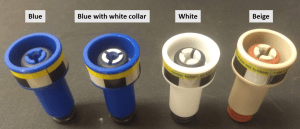PLEASE READ this document carefully before using the AV400 for the first time!
If you have completed the Bruker automation training, you can use the AV400. If you are new to the facility, please look at the training options here.
The AV400 is located in room B-73 in S.T. Olin Laboratory and is best used for routine spectra on reasonably concentrated samples. This is a 400 MHz instrument equipped with a room-temperature probe, so its sensitivity is around 20% of the AV500 and AV501. It should be suitable for 1H and 19F spectra on samples with 1+ mg analyte and other nuclei on concentrated ones (10+ mg). If your spectrum is too noisy after the standard sub-10-minute experiments, re-running the same experiments on the AV500 or AV501 is a much more efficient way to improve sensitivity than running them longer on the 400. It has the lowest probe background in 19F spectra and is the only spectrometer in the facility capable of running 1H/19F double resonance experiments. It is also very good for high-receptivity, quadrupolar nuclei like 23Na and 27Al. Ask us if you are interested.
IMPORTANT: You MUST use ONLY WHITE or BLUE WITH WHITE COLLAR spinners with the AV400!

The changer doesn’t “see” blue spinners and stops working, taking the queue with it. We are replacing blue spinners with white ones as they break, but in the meantime, if we are out of usable spinners, you have to wait until one becomes available.
The main features of the instrument are:
- Bruker AVIII HD electronics console
- BBFO broadband probe.
- SampleXpress™ 60-position sample changer
- Fully automated operation
- IconWeb™ web-based user interface
- Sample temperature range: -150 to +150°C. Default temperature is 25°C (298K).
What can it do?
We have the following experiments set up in IconWeb:
- 1H experiments:
- H1-quant: Quantitative 1H (4 scans, 90° excitation, 30 s relaxation delay)
We recommend this experiment because it combines more-than-good-enough sensitivity on most samples with excellent quantitation across all hydrogen environments. - H1: Semi-quantitative 1H (16 scans, 45° excitation, 2 s relaxation delay)
This experiment sacrifices quantitation (expect aromatic and vinylic hydrogens to integrate lower than they should) for a ~60% increase in sensitivity relative to the quantitative experiment. Since sensitivity is rarely an issue with a cryoprobe, this is not a trade-off we recommend for routine use. - H1-WET-1F: 1H with single frequency signal suppression. Used for acquiring spectra in non-deuterated solvents with a single resonance (CHCl3, CH2Cl2, etc.) or for samples in deuterated solvents that contain a single intense, unwanted signal.
- H1-WET-2F: 1H with two frequency signal suppression. Used for acquiring spectra in non-deuterated solvents with a two resonances (THF, MeOH etc.) or for samples in deuterated solvents that contain two intense, unwanted signals.
- WATERSUP: 1H in H2O/D2O mixtures. Will suppress the water signal but may also wipe out analyte signals close to the water chemical shift. Available by request.
- 1H with 19F decoupling (ONLY on the AV400!)
Not available on the AV500 or AV501. This experiment can help simplify multiplets by removing couplings to 19F.
NOTE: You must set o2p in IconWeb to be within 40 ppm of the 19F signal you want to decouple. - 1H with 31P decoupling
Do NOT change parameters! Available by request.
- H1-quant: Quantitative 1H (4 scans, 90° excitation, 30 s relaxation delay)
- 2D Experiments:
- 2D gCOSY: 2D experiment that connects coupled protons. It’s very quick (4.5 minutes) and robust, and can help you trace networks of neighboring hydrogens. We highly recommend running one for every new compound.
- 2D HSQC: 2D experiment that connects hydrogens with the carbons they are attached to. It’s more sensitive than a 1D carbon and provides multiplicity information like a DEPT135. It takes about 5 minutes and should work for most samples with 1+ mg analyte. Please note that you will not see quaternary carbons as well as a few others, like terminal alkynes. Ask us if you have questions.
- 2D HMBC: 2D experiment that connects hydrogens with neighboring carbons. It’s more sensitive than a 1D carbon and will detect quaternary carbons if they are within three or possibly 4 bonds of a hydrogen. Try it out and we’ll help you with the analysis.
- 13C experiments:
- 10 minute, non-quantitative 13C.
If that’s not long enough, or you want a quantitative 13C, use the AV500 or AV501 instead.
- 10 minute, non-quantitative 13C.
- 31P experiments:
- 31P with 1H decoupling
- 31P without 1H decoupling
- 19F experiments:
- Semi-quantitative 19F
Lower sensitivity than AV500/501 but much cleaner baseline. Quantitative 19F requires that you adjust acquisition parameters based on your sample. Contact us and we’ll show you how. - 19F with 1H decoupling (ONLY on the AV400!)
Not available on the AV500 or AV501. This experiment can narrow 19F lines and simplify 19F multiplets by removing couplings from 1H.
- Semi-quantitative 19F
- H2-lock-coup: 2H spectrum via the lock channel
- If you would like to do other experiments, please contact us!
You can access the AV400 IconWeb interface at https://av400.nmr.chem.cornell.edu (Requires Eduroam from campus and VPN off campus)
